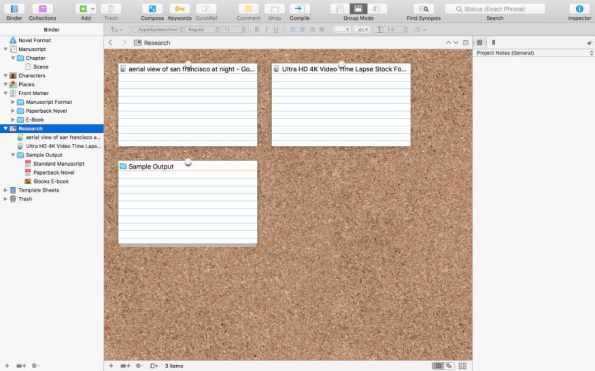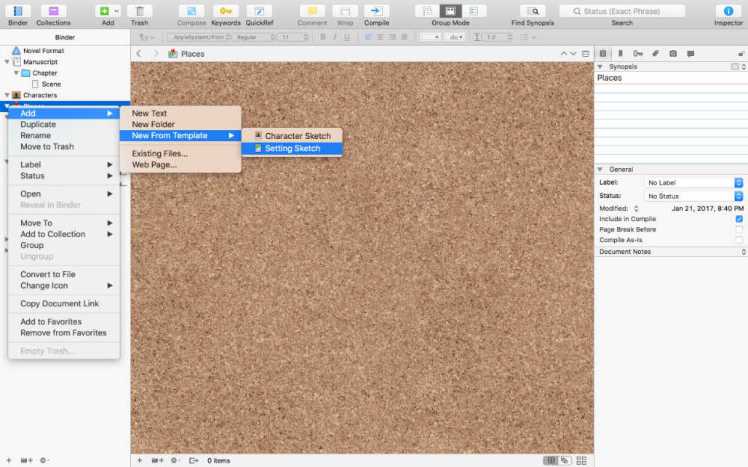Here are some more thoughts on Scrivener, presented as notes I’ve taken while I’m actually using it to create my next novel length story.
Notes:
A really great feature is you can “archive” a website into the Research section of your binder. Very handy for me, because I’ve been keeping dozens of tabs open on Safari, and I’m paranoid that I’ll accidentally close Safari and lose them all (because I haven’t figured out how to reopen Safari with all my tabs intact, or if that’s even possible).
Here’s a screenshot of virtual index cards that Scrivener creates for the websites you “archive” under the research tab. The entries under the Research tab on the left (which is highlighted in blue) function like internal links. Clicking on them brings up the website you add, even if you’re not on connected to the internet.

Characters
Character Template Sheets have the potential to be huge wastes of time, but unlike the “character quizzes” and “interview your characters” templates I’ve seen around the web, this template has two suggested entries that can vastly improve a story: Habits/Mannerisms and Internal Conflict.
Habits and Mannerisms forced me to *see* supporting characters more clearly rather than depend on dialogue to do most of the heavy lifting when it comes to revealing their thoughts and background.
Internal Conflict forced me to be honest about whether or not I was using a secondary character as a crutch to keep a plot hobbling forward, or if the secondary character had a legitimate reason for existence.
(For alternate/additional entries, or another approach to using this template, check out the Character 5×5 list here.)
Here’s a screenshot of how to add a “Character Sketch”. Two-finger click (I think it’ll be right-click on a mouse) on the little arrow to the left of “Characters.” ! That arrow might be pointing to the right, or pointing down, but it’s that arrowhead.

Here is what the Character Sketch Template looks like, with my thoughts on the suggested entries.

Here is the complete text of my notes on the suggested entries:
Sample McSampleface
Role in Story
Main characters are usually the first people that pop into my head, but this section forces me to consider my supporting cast. Do I *really* need Sidekick McSidekickface The Third? Does her role come from her own self-serving motivations (it should), or does she just exist so my Main Character has to go from point A to point B to continue the plot?Occupation
This is like the mortar holding all the big things (Personality, Role, etc) together. Occupations often have their own jargon (specialized language) that can be peppered into dialogue.Physical Description
For me, this is the least important part of a story and I’ll rarely give a detailed description of anyone unless the details matter to the plot (a birthmark or the way someone parts their hair) or reinforce worldbuilding (maybe a hair color dictates a character’s socio-economic standing).This section is useful for continuity if you’re writing a series, so a main character or Love Interest doesn’t suddenly have blond hair in book 3 when he had brown hair in book 1.
Personality
When I was single and people set me up on blind dates, the first thing I would ask was “what’s his personality like?” and the reply was almost always, “Oh, he’s really nice. And he’s a [insert occupation here]. He insert hobby here] all the time.” Personality goes beyond *niceness*, and the last two are not even personality traits but can be influenced by personality traits.Here’s an easy way to remember what Personality Traits are: SOCKS. Note down how Social, Open, Conscientious, Kind, and Stable they are. Here are some examples of how to use this criteria to flesh out characters.
Social: are they more extroverted or introverted, shy or assertive?
Open: are they very open and curious, or closed-minded and staunchly rigid in their beliefs?
Conscientious: are they mindful about themselves, honest, with clear self-defined goals and ideas of right/ wrong or just/unjust, or are they careless, dishonest, chaotic?
Kind: are they kind and generous and gain friends easily, or are they mean, stingy, difficult to get along with?
Stable: are their emotions reliably stable — do they react in a socially acceptable manner, or do they tend to lash out, react with disproportionate anger?Caveat: Dialing all five aspects to one extreme or the other — super kind, curious, friendly, emotionally predictable, and goal oriented vs a mean, closed-minded, unfriendly, unpredictable, and careless person — can result in a Mary Sue; you might create characters that are “too good to be true” or so “perfect” that they’re difficult to like, completely predictable and boring, or hard to relate to.
Memorable characters have personality profiles that are complex mosaics: Scout, the precocious kid; Dexter, the likable serial killer; Harry Potter, the reluctant hero; Walter White, Scarlett O’Hara, Carrie White, etc.
Habits/Mannerisms
Giving a character habits/mannerisms is often overlooked, but it can accomplish several things and give meat to a story. It can reveal more of a character’s personality, like the classic “pet the dog” trope that reveals a tough character’s kind heart. It can reinforce a theme, like Dexter’s habit of calling his compulsion his dark passenger. It can make an impact on the plot, like when Megamind — wait, I’m not going to spoil that plot.Caveat: If a character doesn’t have a reason for having a habit or mannerism, it can come off as silly or frustratingly unnecessary to the reader. Also, be sensitive about using mental issues as a reason for a habit. For example, obsessive compulsive disorder is a complex issue and behaviors that come from this disorder don’t instantaneously resolve at convenient times.
Background
To me, this is the most vague aspect of this character sheet. I’m probably not going to use it because the most important information is covered in the other sections.Internal Conflicts
This is an excellent prompt. A classic example of this is Dexter’s constant internal conflicts between the compulsion to kill, and this desires to not get caught, maintain his family-man facade, protect his sister/help her further her career.This is an important prompt for secondary/supporting characters. If you can’t come up with an internal conflict for all your points of view, you need to pare down the number of mains. If you can’t come up with internal conflicts for your secondary/supporting characters, you might be using them as stereotypes or plot devices.
External Conflicts
This is also an excellent prompt. Here are the classic conflicts:
Man vs. Man (Superman vs. Lex)
Man vs. Nature (Cast Away, Jaws)
Man vs. God/Fate (Greek Myths)
Man vs. Supernatural (The Ring, Dracula, “The Yellow Wallpaper”)
Man vs. Technology (Ex Machina, “Daddy’s World”)
Man vs. Society (Brave New World)For me, this isn’t as important as Internal Conflicts when it comes to secondary/supporting characters, so I’m not going to spend too much time on this for them.
Halfway through filling out Settings Templates under the Places Tab:
I feel like I’m wasting my time on this when I could be writing. But I also feel like taking time to fill out these notes will save me time later on; I won’t be repeatedly looking things up, and I’ll have information in a handy location if I need to refer to specifics during revision.
A big weakness, in my opinion, is that the suggested entries are more like reminders than challenges. Superficially, they don’t challenge your skill as worldbuilder, and they don’t challenge the *truth* of the world you’re building. You’ll have to come up with your own notes-prompt to integrate a location into the plot, and to make sure that location becomes a character in its own right.
For example, Unique Features and Description and the three entries that follow are all redundant. I like that Smell is included as a prompt — that’s often forgotten — but you could also add story-specific details, especially if you’re writing Fantasy (your world’s magic system and the laws that govern it) or Science Fiction (note socio-economic information pertinent to your story, like laws governing healthcare).
Here’s a screenshot of how to add a Setting Sketch into the Places Tab.

Although I know I can use this program however I want – I can complete or abandon any section – I feel compelled to complete sections because it’s forcing me to consider the importance of my choices (do I really need this character, how much will this location impact the plot, am I giving all the characters in the scene their own motivations).
Again, I can see how I could spend way too much time on filling out these templates. I need to impose deadlines, like “I’m going to finish all the character templates by tonight.”
Final thoughts on the Research, Characters, and Places Tabs in Scrivener:
I’ve finished all the Character Sheets and Places Sheets for my story. I’ve also imported or “archived” the websites I need to refer to. I feel like I can finally actually *write* the damn thing, but I’m going to try something out which should take advantage of Scrivener’s modularity: I’m going to do an outline by adding new sheets under the “Chapter” file, one for each chapter. On the right side, in the synopsis panel, I’ll write notes regarding what elements need to go in that chapter.
A plus for Scrivener: I can change the order of settings in the Places folder to reflect the order of settings in the story. That will help me do the outline.
While doing the outline, I’m using Places locations as chapter headings. I’m seeing where two or more locations don’t each need a chapter, which should improve my pacing.
Have questions?
Contact me by leaving a comment below, on Twitter (@JoanWIP), or Facebook.
And for more writing tips, recipes, or posts on being a Mom in the Bay Area, follow this blog via the Follow link at the top of the page.
Sharing is caring! I appreciate Pins, Reblogs, Facebook shares and Twitter Tweets!
For fans of Self-Rescuing Heroines, Science Fiction, Fantasy, SciFi-Fantasy hybrids (Science Fantasy), Sword and Sorcery, Arthurian legends, and Female Protagonists, check out my novella series, Take Your Daughter to Work Day.
Part 1 of the series. “Take Your Daughter to Work Day” Anne Dwarding discovers her mom’s secret job, secret life, secret mission.
Part 2 of the series. “A Mile in My Shoes” Anne must earn her keep by retrieving DNA from Cinderella’s slippers.
Part 3 of the series. “The Glass Cathedral” pits Anne against an ancient entity whose very existence challenges her faith and forces her to choose between sacrificing someone to get the help she needs, or upholding her beliefs at great personal cost.
Now available on Amazon! A Self-Rescuing Heroine in a Gothic tale with a modern twist.
Hang out in my mental playground! For cheaper than a Pumpkin Spice Latte, my highly-rated short stories are available on Amazon, Fresh Cuts: Breaking Volume and Fresh Cuts 2: Skinning Volume. #Fantasy #SciFi #Horror #Fables #Fairytales #SelfRescuingHeroines #DiverseBooks.
Fresh Cuts 2: Skinning has been reviewed as “Smart” “Fresh” “Disturbing” and “the part of Wonderland people don’t talk about”!
Fresh Cuts: Breaking has been reviewed as “Twisted” “Hilarious” and a “Delightfully perverse collection”!





